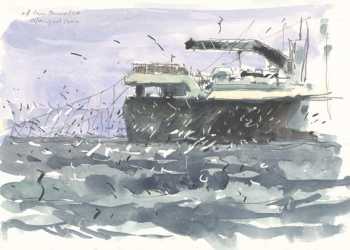The following text is quoted from The Namibian of 13 March 2014 (click here).
“Every year in Namibia some 20 000 seabirds are accidentally killed when coming into contact with the trawlers and longliners.
The Albatross Task Force (ATF) based in Walvis Bay funded by Birdlife International and Royal Society for the Protection of Birds (RSPB), implemented in partnership with the Namibia Nature Foundation (NNF) and Ministry of Fisheries and Marine Resources (MFMR) [aims] to reduce the incidental mortality of seabirds off the Namibian coast.
The ATF was invited to Lüderitz from 18 to 21 February by Novanam Pescanova to do training on mortality mitigation techniques for fishing vessels. The mortality mitigation techniques involve the use of paired tori lines or bird scaring lines which are placed on the stern of each trawler. The tori lines prevent seabirds, particularly albatross from flying into the warp cables and net of trawlers. The use of tori lines and proper offal and discard management (no discarding during hauling) helps to reduce the seabird mortality by more than 80%. The tori lines are a very effective solution for saving seabirds as well as for more efficient fishing practices with less bycatch.

A southern African trawler tows twin bird-scaring lines
Painting by Bruce Pearson
Novanam Pescanova is the first fishing company in Namibia to implement these simple but effective mitigation techniques to help reduce the incidental bycatch of seabirds in the fishing industry. During the training a comprehensive presentation about the threatened species of albatross and how to use tori lines was given to four groups of fishermen from hake trawlers. In total 34 people were trained. Each trawler requires three tori lines (two in use, one as spare) and each longliner requires two tori lines (one in use, one as spare). Once there was an understanding of the dangers albatross and other seabirds face the ATF visited each fishing vessel to demonstrate how to deploy the tori lines. It is very important that Namibian fishing companies use these tori lines as Namibia has the deadliest seas in the world with regards to seabird mortality. The ATF is ready to work with all fishing companies in Walvis Bay and Lüderitz on how to use these mitigation techniques both on trawlers and longliners.
Jose Santome, a captain from one of the trawlers mentioned, “We do not know what a tori line is. We saw them on the boat but we don’t know what they are used for.” “I now understand what tori lines are and how to use them”.”
Click here for a similar news item of 12 March 2014 from The Namib Times.
Namibia drafted a National Plan of Action for Reducing the Incidental Catch of Seabirds in Longline Fisheries (NPOA-Seabirds) following Food and Agriculture Organization of the United Nations (FAO) guidelines (IPOA-Seabirds) over the period 2003-2007 but it has, as yet, not been formally adopted.
View adopted NPOA-Seabirds on the FAO website here and see ACAP's NPOA-Seabirds list here.
With thanks to Robert Vagg for information
John Cooper, ACAP Information Officer, 18 April 2014

 English
English  Français
Français  Español
Español